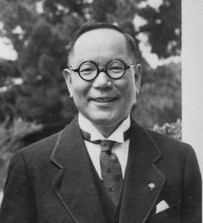- Tatsuo Kawai (diplomat)
Persondata
NAME = Kawai, Tatsuo
ALTERNATIVE NAMES =
SHORT DESCRIPTION = Japanese diplomat and author
DATE OF BIRTH = 1889
PLACE OF BIRTH =Fukuyama, Hiroshima ,Japan
DATE OF DEATH = 1965
PLACE OF DEATH =Japan Infobox Person
name = Tatsuo Kawai

image_size = 203px
caption = Tatsuo Kawai, c1941
birth_name =
birth_date = 1889
birth_place =Fukuyama, Hiroshima ,Japan
death_date = 1965
death_place =Japan
death_cause =
resting_place =
resting_place_coordinates =
residence =
other_names =
known_for =
education =
employer = Foreign Ministry
occupation =Diplomat ,author
title =
salary =
networth =
height =
weight =
term =
predecessor =
successor =
party =
boards =
religion =
spouse =
partner =
children =
parents =
relatives =
nationality =Japan ese
website =
footnotes = nihongo|Tatsuo Kawai|河相達夫|Kawai Tatsuō (1889 - 1965) was aJapan ese diplomat and author [cite web|url=http://www.mofa.go.jp/mofaj/annai/honsho/shiryo/qa/senzen_04.html|publisher=Ministry of Foreign Affairs, Japan|accessdate=2007-04-26|title=外交史料 Q&A 昭和戦前期 (Foreign Affairs Archives Q&A: Showa pre-war period)] . He was a leaning proponent ofexpansionism in Japan beforeWorld War II but later became a pacifist and was Japan's firstAmbassador toAustralia .Early years
Kawai was born in Fukuyama,
Hiroshima Prefecture . graduated from Tokyo Imperial University in 1915. He passed the diplomatic service examination in 1918 and was appointed vice-consul toTsinan ,China in 1919. He was promoted in 1921 and served as Secretary to the Japanese Embassy inWashington, D.C. and then Secretary to the Department of Commerce in 1921. He became the Japanese Consul toVancouver in 1925 and Tsingtao in 1928. He became Chief of the Foreign Department of theKwantung Leased Territory in 1930 and Secretary to the Japanese Advisor to the Lytton Commission of theLeague of Nations .He was appointed Consul-General to Canton in 1934 and
Shanghai in 1938. Kawai was an ardent expansionist and in 1938 published "The Goal of Japanese Expansion", which was published in both Japanese, English and Russian and the following year translated into Spanish. In 1938 he also published 支那事変と帝国外交 ("The China Incident and Imperial Diplomacy"), which was only available in Japanese. [cite web|url=http://www.toyo-bunko.or.jp/cgi-bin/MCT.cgi?n=12.24&db=J|title=日本側|publisher=Tōyō Bunko |accessdate=2007-04-26]In 1938 he was promoted to Director of the Information Bureau and official spokesman for the Foreign Ministry in Tokyo. In 1939 he served briefly as Japanese Envoy Extraordinary and Minister
Plenipotentiary to Europe and the United States before returning to Japan. Sir Robert Craigie, British Ambassador to Japan, later noted that "during his term of office as official 'spokesman' ... he displayed on several occasions open hostility to our attitude as regards Japanese actions inChina and he was unpopular amongst the foreign newspaper correspondents owing to his somewhat rough manner and indifferent command of English". [cite web|url=http://www.info.dfat.gov.au/info/historical/HistDocs.nsf/d30d79e4ab5621f9ca256c8600163c0d/484f9f942e60fd2bca256b7e00122f98?OpenDocument|title=Sir Robert Craigie, U.K. Ambassador to Japan, to Mr A. Eden, U.K. Secretary of State for Foreign Affairs, 21 January 1941|accessdate=2007-04-23] After leading a strike at the Foreign Ministry in 1940, he was sacked as an official spokesman but was appointed roving ambassador to Nazi-occupied Europe. It was during this appointment he became a pacifist.Ambassador to Australia
Kawai's appointment to his new position as Japan's first
Ambassador to Australia was officially announced on2 January ,1941 ; he arrived in Australia on13 March of the same year. [cite book|title=Current Notes on International Affairs|publisher=Australia Department of External Affairs|date=1942|page=132] Kawai developed a close friendship with futurePrime Minister of Australia John Curtin . In early 1941, when Curtin was still Leader of the Opposition, they reached an agreement to boost trade and to allow Japanese access toiron ore inWestern Australia in exchange for Japan "guaranteeing Australia's safety".Wurth , B. "Saving Australia, Curtin’s secret peace with Japan", Lothian Books, 2006.] In July 1941, "Time" quoted Kawai as saying he was tired of hearing the word "drive" to describe Japan's intentions and that territorial expansion was an old-fashioned phrase. [cite web|url=http://www.time.com/time/magazine/article/0,9171,795413-1,00.html|title=Southward Ho?|accessdate=2007-04-23]He was the guest of honour at a formal dinner held by Curtin in Perth and dined privately with the Curtins many times. He was also a guest at
The Lodge after Curtin became Prime Minister, and at the opening of theAustralian War Memorial inCanberra onNovember 11 ,1941 . He sent a telegram to Curtin expressing his sympathy at the loss of HMAS "Sydney" onNovember 27 ,1941 , only days before Australia declared war on Japan.WWII
Kawai warned Curtin at the conclusion of the American–Japanese talks in
Washington, D.C. that "the momentum may have gone too far" to prevent war, prompting Curtin to recall his War Cabinet onDecember 5 ,1941 . [cite web|url=http://primeministers.naa.gov.au/meetpm.asp?pmId=14&pageName=inoffice|title=John Curtin, In Office|accessdate=2007-04-23] Kawai was kept underhouse arrest at the Japanese embassy at the outbreak of thePacific War and deported to Japan in August 1942, taking with him the ashes of four of the Japanese submariners killed in theattack on Sydney Harbour .Kawai was ostracised in Japan when he called on Japanese not to hate AustraliansWurth , B. "Saving Australia, Curtin’s secret peace with Japan", Lothian Books, 2006.] and was sacked from the Foreign Ministry. Towards the end of the war he secretly worked for peace with
Shigeru Yoshida . Immediately after the war he became vice foreign minister under Yoshida.Later life
After the war he became head of the
Japan Australia Society , an organisation promoting trade and friendship between the two countries. He resumed contact with the Curtin family, even visiting John Curtin's grave in 1959.He died in 1965.
His son,
Masumi Kawai , became managing director ofMitsui 's Australian subsidiary, Mitsui Australia.Publications
* 支那を如何に觀察すべきか (Shina o ika ni kansatsusubeki ka), 1937 [Translation required]
* "The goal of Japanese expansion" (English), Hokuseido Press, Tokyo, 1938. (Reprinted: Greenwood Press, Westport, 1973)
* (Tseli iaponskoi ekspansii), (Russian), JuMZD, 1938.
* 發展日本の目標 : アジア體制への道 (Hatten Nihon no mokuhyō: Ajia taisei e no michi), 中央公論社, Tōkyo, 1938 [Translation required]
* 支那事変と帝国外交 (Shina Jihen to Teikoku gaiko, "The China Incident and Imperial Diplomacy"), 1938
* 事變解决の根本は何處にありや (Jihen kaiketsu no konpon wa doko ni ari ya), 青年日本運動, 1938 [Translation required]
* "Las finalidades de la expansión Japonesa" (Spanish translation), Santiago de Chile [s.n.] , 1939.References
Wikimedia Foundation. 2010.
